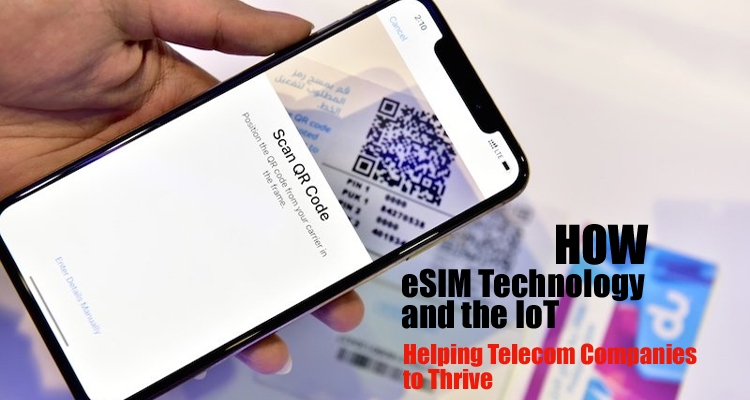eSIM Technology and the IoT: How They Help Telecoms Companies Thrive
Let’s understand what eSIM technology is and how it is helping telecommunication companies to grow using the latest technology.
Most people would be familiar with subscriber identity modules or SIM cards – those tiny, removable chip-containing cards placed inside mobile phones that enable users to connect to a particular mobile network and make phone calls, send text messages and use other features.
These cards have played a major role in global mobile telecommunications for over 25 years, but these days, a new kind of SIM is relishing its rightful place in the spotlight.
eSIM cards or embedded SIM cards are expected to become an integral component of everyday business within the mobile industry in no time.
If you’re still on the fence about how this technology can be beneficial to mobile network operators or mobile virtual network operators (MNOs/MVNOs) and original equipment manufacturers (OEMs) like you, here are brief answers to four common questions about eSIMs, what they have to do with ?the Internet of Things (IoT), and how they can revolutionize the telecommunications industry.
Also Read: 6 Ways to Use Technology to Grow Your Business in Dubai
1. What Is an eSIM?
The traditional plastic SIM card, provided by and locked to a specific mobile network, fits into a tray that pops out of a phone. This makes it easy to transfer the SIM from one device to another. If you wish to change your plan, the mobile carrier would have to do it for you.
The eSIM, in contrast, is built into a mobile device. It is fixed inside, and the mobile carrier information is saved directly within the device instead of in a physical SIM card. The absence of a card tray means there is more valuable space for the battery, camera module or other features.
An eSIM can be used on any supported phone and does not require mobile network intervention to be activated or deactivated.
It also allows users to have both personal and work phone numbers in one device, as well as a foreign SIM when travelling abroad. The eSIM can be set up by simply scanning a QR code.
Also Read: Technologies that Change Financial Processes in the UAE
2. What Is the Internet of Things(IoT)?
Let’s move on to IoT.
The Internet of Things is a massive network of connected ‘things’. Things could refer to just about anything beyond computers and smartphones (e.g., headphones, washing machines, coffee makers, wearable devices, transportation networks, processes, environments, and even people and animals) that can connect to the Internet and to each other.
IoT can transform the way people engage in activities, but it is also exciting to see what this connectivity would look like on a larger scale – say, within businesses and entire industries.
The Internet of Things can be beneficial to industries, such as healthcare (through wearable technology that can streamline administrative processes in hospitals), transport and logistics (that require fleet- and asset-tracking systems for vehicles and cargo with the help of real-time GPS location details).
But there’s another industry where IoT truly stands out: telecoms.
Also Read: Technologies Reshaping Investment Solutions in UAE Today
3. How Is IoT Applied to the Telecoms Industry?
It makes sense for the Internet of Things to be heavily observed in ?telecommunications since network providers need it to create better connections between people and devices.
Here are examples of ways IoT can be leveraged by businesses in this industry:
- IoT sensors enable monitoring of device performance in places like warehouses and factories.
- IoT can be used to power cameras and beacons for security purposes.
- Companies can use IoT to track and trace the data and information they share with their customers.
- Businesses can provide location-based services with the help of proximity sensors in devices.
- Autonomous vehicles can have smooth communication thanks to 5G in mobile devices and IoT-powered sensor fusions.
- Operators can build enhanced predictive analytics models using IoT.
In the analyst house, Machina Research’s IoT Forecast Database Research back in 2017, GSMA revealed ?IoT is expected to generate about USD 1.8 trillion in revenue for MNOs by 2026. The research pointed to huge growth opportunities for mobile operators, thanks to IoT services and applications.
That means there is an increasing demand for digitisation strategies, such as turning to eSIM to facilitate IoT devices. According to GSM Intelligence, by the end of 2025, there will be 2.4 billion eSIM smartphone connections across the globe.
MNOs/MVNOs and OEMs, along with other businesses, will surely want to partake of this opportunity to increase their share of the eSIM market.
Also Read: Prepaid SIM Card in Dubai: Price and Where to buy it
4. How Do eSIM Innovations Revolutionise IoT?
SIM and eSIM providers typically offer two solution channels:
The consumer solution.
Consumer eSIMs enable the cellular connectivity of different consumer devices such as mobile phones, laptops or tablets. They then connect to consumer IoT devices like voice assistants and wearable tech.
The machine to machine or M2M SIM solution.
In contrast, this is designed for B2B customers in need of IoT capabilities. Two devices connect using either wired or wireless communication channels. Examples of M2M and IoT devices are metres, trackers, machinery, and sensors – and there are no end users.
Companies involved in manufacturing, logistics, construction and, of course, telecommunications can benefit from eSIM technology. Such businesses may typically need to manage complicated supply chains.
For example, telcos with resellers, multiple vendors or vertical specialists, a solution such as a Multi eSIM Hub or MESH by Workz comes in especially handy. It allows greater convenience and efficiency when managing multiple tenants, sites, platforms and sales channels.
Features of this eSIM hub include:
- A single customisable interface that allows real-time monitoring and consolidated reporting
- Self-administration functions
- Full security (server partitioning protects each tenant’s data)
- Management automation
- Full profile management
- Plug-and-play system
The Multi eSIM Hub offers telcos a unique platform that offers a diverse range of onsite and cloud hosting options that provide key capabilities:
- You gain a competitive advantage. Using an interoperable and platform-agnostic system gives you a sure edge in your market.
- You demonstrate consistent efficiency. Managing all of your tenants’ or resellers’ eSIMS is quick and easy to do.
- You ensure redundancy. The hub can maintain continuity with an enhanced system redundancy.
Evolving Connections
Digitisation in this day and age is crucial, and eSIM technology combined with the Internet of Things can make effective and efficient mobile networking functions better.
Business leaders would do well to adopt these innovations to experience and benefit from a wonderful digital transformation.
AUTHOR BIO
Emily Roberts is a business development executive at Workz, a top Dubai-based provider of secure connected solutions for consumer, M2M and IoT devices. Tor has over 25 years’ experience in telecoms distribution for companies such as Nokia Siemens, Brightpoint and Millicom. Workz is one of the global leaders in mobile IoT, one of only five providers in the world to be certified by the GSMA to manage the complete eSIM lifecycle, and the world’s largest manufacturer of telecom (SIM and prepaid) cards.




